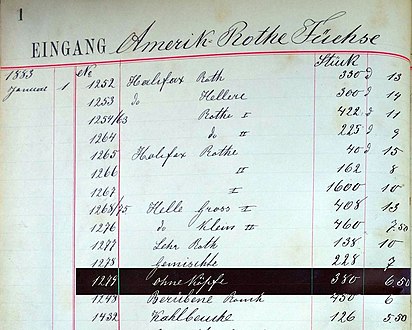Skulls

Heads , but above all top heads , was the valuation and designation customary in the German-speaking fur industry for the selected good and also the largest furs of a species.
The now hardly used, concise definitions heads, top heads and sub-heads have been mainly in marten pelts , but also for polecat skins , fox skins , Bisamfellen and Kaninfellen used. In the German auction reports they were specially listed and rated, such as: pine marten, upper heads, etc. The Kanin trading company in Leipzig offered rabbit skins under the Ia variety, the so-called upper heads: extra large skins, with white leather, well treated. At least in Russia, the same terms were used in Russian-speaking trade.
According to a fur lexicon, the largest and most valuable East Prussian sable pelts were traded as the upper heads of East Prussia . However, red fox skins were also offered under the name Oberköpfe East Prussia. Around 1928/1929 listed on the Leipzig tobacco market : East Prussia prima for 27.50 to 45 marks; Mountain fox heads for 50 to 65 marks.
- From the stock book of Naoum Dedo from Leipzig, January 1883
- For example, the German fox range was divided as follows:
| designation | description | |
|---|---|---|
| Skulls | = | Selected (selected goods) |
| Great white leather | = | I. variety; perfect |
| Great green leather | = | 1st variety, slightly green leather |
| Three quarters | = | II. Variety; green leather (transition) |
| Half | = | III. variety |
| quarter | = | IV. Variety |
| Rinds | = | Flat summer skins |
| Slightly damaged | ||
| Damaged | ||
| shot |
- Around 1928/29, the Leipzig tobacco market listed per item:
- Raw pine marten skins: quality great 75 to 120 marks, tops of the heads 120 to 160 marks
- Raw stone marten skins: great 60 to 75 marks, upper heads 70 to 85 marks.
In 1983 Walter Grigull remembered his time as a young forester in East Prussia:
“The external officials were able to catch some martens in barriers and marten traps every year and use them for their own account. The East Prussian tobacco products were traded in the Leipzig headquarters of the fur trade with a surcharge of 20 percent. The so-called upper heads of foxes and martens were often bought. In the inflationary period before 1924, traders paid for the marten and fox hides with dollar treasury notes , which were stable in value and had unheard-of purchasing power. For the proceeds of a marten hide you could buy two suits. "
Marginalia
In 1979 the fur branch cone club "Oberköppe" with 22 members, "a healthy mix of branch members of Saxon and Hanseatic blood", existed in Hamburg for over 25 years.
Individual evidence
- ↑ a b Alexander Tuma: Pelz-Lexikon. Fur and Rauhwarenkunde, Volume XX . Alexander Tuma, Vienna 1950, p. 71 , keywords "upper heads, upper heads East Prussia" .
- ↑ Results of the game auction of the animal hair recycling Mucrena, Leipzig . In: Der Rauchwarenmarkt , January 25, 1922, No. 20, p. 2.
- ↑ a b Alexander Tuma: Pelz-Lexikon. Fur and Rough Goods, Volume XIX . Alexander Tuma, Vienna 1950, p. 64–65 , keyword “heads” .
- ↑ a b Christian Franke / Johanna Kroll: Jury Fränkel 's Rauchwaren-Handbuch 1988/89 . 10th revised and expanded edition. Rifra-Verlag, Murrhardt 1988, p. 150, 222, 367 .
- ↑ Information from the tobacco shop Klaus-Dieter Ribak, Frankfurt am Main, October 25, 2018.
- ↑ a b Kurt Nestler: Tobacco and fur trade. Dr. Max Jänecke Verlagbuchhandlung, Leipzig 1929, pp. 105–106.
- ↑ Walter Grigull: The fate of the wilderness sealed - Walter Grigull (V) reports on the Gauden border forest . In: Das Ostpreußenblatt , volume 6, February 15, 1983, p. 13 (PDF). Last accessed October 16, 2018.
- ↑ Gustav A. Demuth: Dear Mr. Winckelmann . In Winckelmann Pelzmarkt No. 516, November 16, 1979, p. 17.
